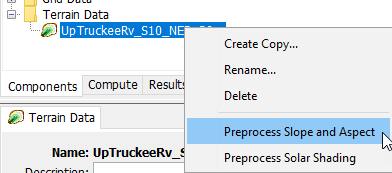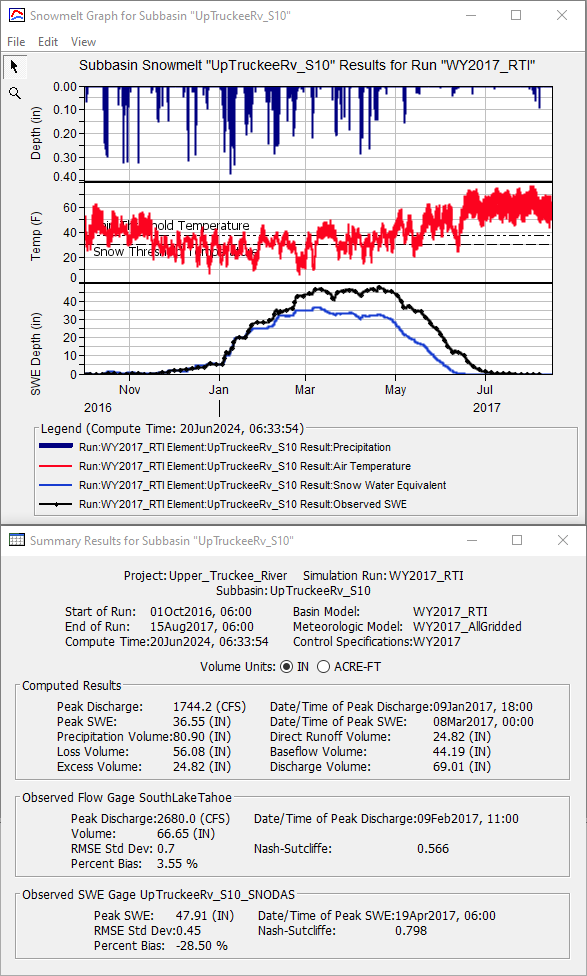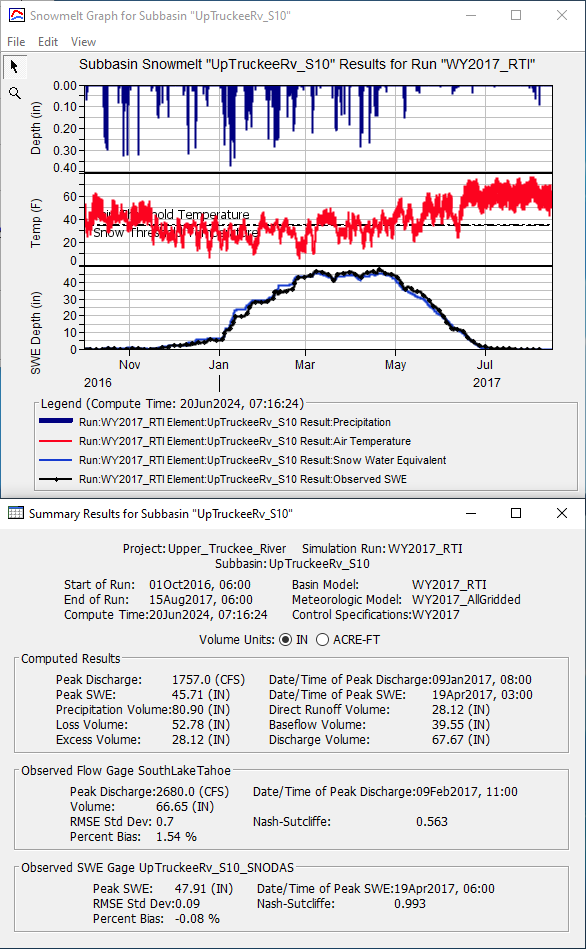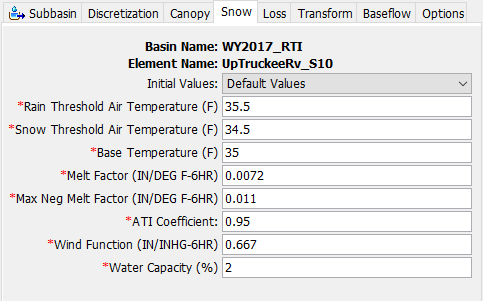Download PDF
Download page Option 2. Gridded Hybrid: Upper Truckee River.
Option 2. Gridded Hybrid: Upper Truckee River
Return to: Introduction to Gridded Snowmelt Calibration
Last Modified: 2024-06-20 13:45:45.934
While the Temperature Index method relies solely upon air temperature to estimate energy available to melt accumulated snow, the Radiation-derived Temperature Index (RTI) or Hybrid method utilizes additional factors to compute a "proxy energy" available for snowmelt. This representative energy is derived from a radiation balance computation that includes simple calculations of net shortwave and longwave radiation (Follum et al, 2015; Follum et al, 2019). Net shortwave radiation includes topographic, cloud cover, vegetation, and albedo effects while net longwave radiation includes contributions from the air, vegetation, cloud cover, and approximate snow temperature. Compared to the Temperature Index method, the RTI/Hybrid approach requires only a few additional meteorological inputs.
Terrain Preprocessing
Prior to computing a Simulation Run with the Gridded Hybrid snowmelt method, the Slope, Aspect, and Solar Shading of the terrain must be computed. These parameters are computed by right clicking on the terrain and selecting Preprocess Slope and Aspect and Preprocess Solar Shading, as shown below.
These steps have been completed for you. You do not need to recompute slope and aspect or solar shading.

Parameterize the Gridded Hybrid Snow Method
- Right click on the WY2017 Basin Model and click Create Copy....
- Enter WY2017_RTI as the name and click Copy.
- Expand the WY2017_RTI node and click the UpTruckeeRv_S10 subbasin node.
- In the Component Editor, select the Subbasin tab.
- Change the Snow Method to Gridded Hybrid.
- Click on the Snow tab.
Enter the following parameter values:
Initial Values: Default
The initial snow states can be set to zero because the simulation will start at the beginning of the WY when there is no snowpack.
- Rain Threshold Air Temperature (F): 37.4
- Snow Threshold Air Temperature (F): 30.2
- Base Temperature (F): 32
- Melt Factor (IN/DEG F-6HR): 0.00722
- Max Negative Melt Factor (IN/DEG F-6HR): 0.011
- ATI Coefficient: 0.8
- Wind Function (IN/INHG-6HR): 0.667
- Water Capacity (%): 3
Create and Compute a Simulation Run
- Select Compute | Create Compute | Simulation Run....
- Enter WY2017_RTI as the name and select Next.
- Select WY2017_RTI Basin Model, the WY2017 Meteorologic Model, and the WY2017 Control Specifications.
- Click the Finish button.
- In the Toolbar, select the WY2017_RTI simulation from the drop-down menu and click the Compute button.
- When the simulation is complete. navigate to the Results tab.
- Expand the WY2017_RTI node and then expand the UpTruckeeRv_S10 subbasin node.
- Select the Observed SWE and Snow Water Equivalent time series nodes to view the results. Alternatively, select the Snowmelt Graph to view Precipitation, Air Temperature, Observed SWE, and Snow Water Equivalent in the same window.
Question 1: Using the initial parameter values, how does your simulated SWE compare with the observed SWE? How will you use the preliminary results to inform your calibration approach?
The initial computed peak SWE is too low when compared against the observed SWE. Also, the computed snowpack melts too soon, as shown below:

As such, parameters related to the accumulation of snow (as opposed to melting snow), should be modified first.
Calibrate the Gridded Hybrid Parameters
Revisit the Gridded Hybrid parameters that you defined in the previous task. Modify the parameters in a systematic way and keep track of the effect of the parameter modifications on the simulated SWE. To assist with calibration, plot the Precipitation, Air Temperature, Observed SWE, and Snow Water Equivalent time series using the Snowmelt Graph. Also, be cognizant of the impact each change has on the computed runoff at the South Lake Tahoe gage location. As such, also plot the computed and observed flow at the SouthLakeTahoe junction.
Attempt to increase the peak SWE by modifying the Rain Threshold Air Temperature, Snow Threshold Air Temperature, and Base Temperature.
Decreasing the Rain Threshold Air Temperature will cause more precipitation to fall as rain, resulting in a shallower snowpack.
Increasing the Snow Threshold Air Temperature will cause more precipitation to fall as snow, resulting in a deeper snowpack.
When the air temperature is higher than the Base Temperature, snowmelt occurs. Increasing the Base Temperature will cause the snowpack to last longer since higher temperatures are required to melt the snow.
- Try setting the Rain Threshold Air Temperature to 35 deg F and rerun.
- Try setting the Snow Threshold Air Temperature to 35 deg F and rerun.
- Try setting the Base Temperature to 35 deg F and rerun.
- Continue modifying to best match the peak SWE date and magnitude.
- Attempt to improve the rate at which snow melts and melt out date by modifying the Melt Factor.
- Try decreasing the Melt Factor to 0.0035 and rerun.
- Try increasing the Melt Factor 0.01 and rerun.
- Continue modifying the Melt Factor to best match the rate at which SWE melts along with the computed melt out date.
- Continue modifying the remaining parameters (e.g. Max Negative Melt Factor, ATI Coefficient, and Wind Function) and note their impact on the computed results.
- Iteratively adjust all impactful parameters to best match peak SWE magnitude, SWE melt rate, the melt out date, and runoff at the South Lake Tahoe gage.
Question 2: Which parameters had the largest impact on the computed SWE? How well does the computed SWE compare against the observed SWE?
Rain Threshold Air Temperature, Snow Threshold Air Temperature, Base Temperature, Melt Factor, and ATI Coefficient are the most impactful parameters. During calibration, these parameters should be changed to afford better agreement between computed and observed results. Also, when assessing model uncertainty, these parameters should be analyzed and attempts made to minimize their contributions to the overall project risk. Minor changes in computed results were achieved through changes in the Max Negative Melt Function and Wind Function.
The computed SWE matches the observed SWE fairly well. However, the date and magnitude of the computed peak SWE is notably different when comparing the observed and computed results. The computed melt out date agrees very well with the observed data:

Question 3: How well does the computed runoff at the SouthLakeTahoe junction compare against the observed data?
The computed runoff matches the observed discharge well. Further improvements could be made for the large period of runoff in early Feb 2017 and the sustained period of runoff in the May-June-July 2017:

Question 4: What were your final Gridded Hybrid parameters for the Upper Truckee River subbasin?
Most notably, the Rain Threshold Air Temperature, Snow Threshold Air Temperature, Base Temperature, Melt Factor, and ATI Coefficient needed to be changed from their initial values to afford better agreement between the computed and observed results:

Continue to: Option 1. Gridded Temperature Index: Upper Truckee River or Option 3. Gridded Energy Budget: Upper Truckee River.
